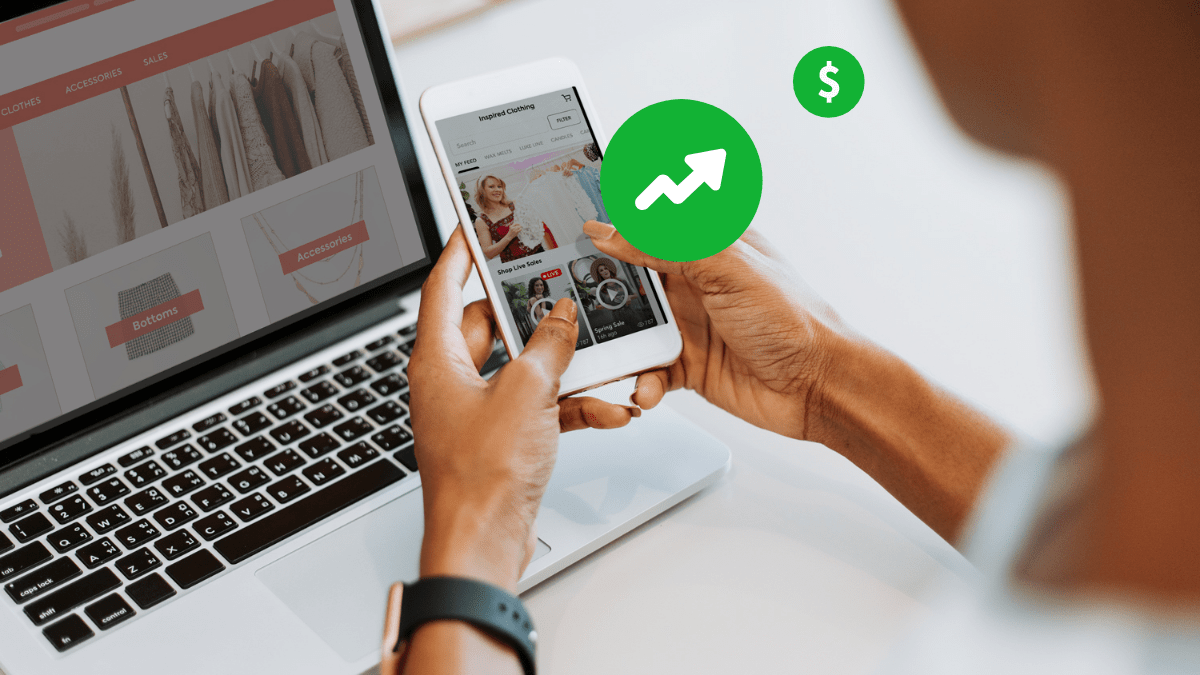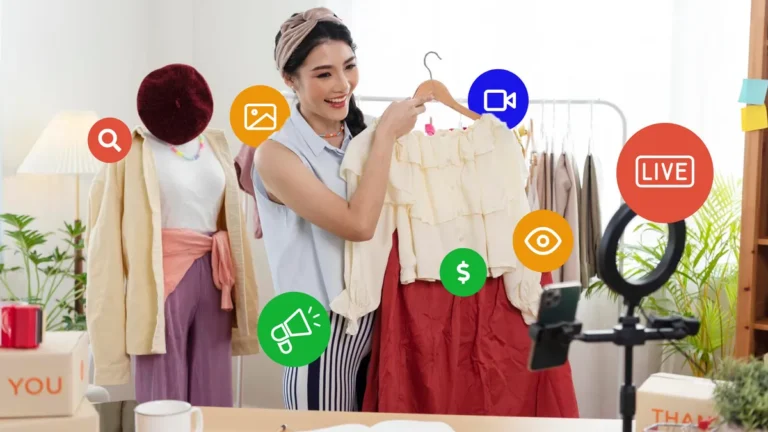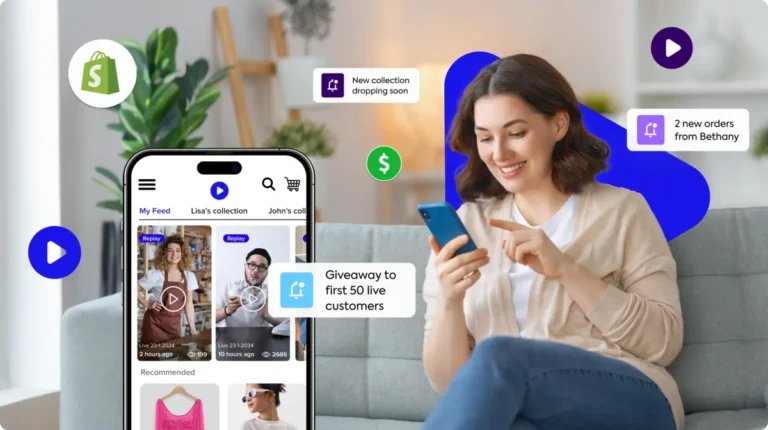If you’ve been wondering how to sell merchandise online, you’re not alone. Businesses need to have a robust online presence to stay competitive in the digital age. It’s no secret that e-commerce has grown rapidly over the past decade, and this trend isn’t slowing down anytime soon. More than 230 million people shopped online in the U.S. in 2021 alone.
E-commerce opens up new revenue streams, helping you reach potential customer groups you may not otherwise found. You can expand your brand with minimal upfront costs. If you’re ready to take your business to the next level by selling products online, read on to discover how to launch your online business more effectively.
How to Sell Online in 11 Easy Steps
Consider different online business models as you prepare to launch your e-commerce brand.
Retail Sales
Many businesses start by selling products directly to consumers in physical stores, then expand to online sales. Others start online and expand to physical stores once the e-commerce business grows. Either way, appealing to end customers is the key to growth for a retail business model.
Wholesale
Do you want to sell products only to other businesses and not directly to customers? Companies that offer wholesale goods can manufacture products at high volumes, and they typically have systems and processes in place to warehouse and fulfill them for their business customers.
Businesses ordering from wholesalers usually have resale licenses, which they acquire from their local municipalities. They must report wholesale sales, charged at a wholesale discount rate without sales tax. The reseller is expected to sell the products at a profit and collect the sales tax from their customers.
Auctions
Online auctions are ideal if you want to know how to sell merchandise to find out what customers think it’s worth. Collectors scour auction sites like eBay for limited-run, unique, or collectible products sold to the highest bidders. Antiques, artwork, stamps, sports memorabilia, jewelry, and designer apparel are sold in auction marketplaces. Online auctions have also become popular for bidding on open-box items, used items, and vintage items.
Dropshipping
If you want to do the selling but don’t want to have physical inventory, you may want to think about dropshipping. With dropshipping, you send orders to a manufacturer, wholesaler, or another retailer that ships products directly to your customers. You can source products to resell from online marketplaces that make products available specifically for resale.
Working with an online dropship marketplace that offers direct fulfillment is tempting for new businesses because you won’t need to carry inventory. However, for that reason, it is also essential to check references and ensure the drop-shipper is reliable in terms of product quality and delivery speed.
No matter what business model you have, you can follow these easy steps to begin selling online:
1. Have a clear idea of what you’ll be selling. If you have products already, you’re a step ahead. If not, do some research and figure out what you want to sell. Find out how much you’ll pay to manufacture or buy your products for resale and how much you can mark them up to sell to your end customers. If you’re making products yourself, figure out how much time goes into crafting each product, and factor your labor into an overhead cost.
2. Create a basic business plan. This piece is crucial to know how to sell products online in your industry or product niche. Creating a business plan will help you estimate how long it’ll take your business to become profitable. Business plans can help you lay out all of your costs and expenses and compare them with your working capital to see how long it may take you to break even and start making a profit. The Small Business Association has free business plan templates to get you started.
3. Register your business with the IRS to get a Tax ID number. This will allow you to open a bank account, get a merchant account, start building business credit, and pay taxes. Once you obtain your Federal Tax ID, you can register with the Secretary of State in the state where you are doing the majority of your business. You’ll need to pay state income tax and pay federal taxes.
You will also have to collect and pay sales taxes in your home state and other states your online customers are making purchases, so registering as a legitimate business early will save you from getting tangled in red tape down the road.
Depending upon your growth plans, there are various options for structuring your business:
- Operate as a sole proprietor
- Incorporate a corporation
- Incorporate as a limited liability company or partnership
How you operate can determine certain legal ramifications, tax breaks, and liabilities, so it’s good to consult with your attorney or accountant.
4. Register the domain name for your online business. You can choose from several domain name registration services. Some offer low-cost domain name packages that include website hosting and email. If your business name is already in use as a web address by someone else, be creative! Some businesses register domain names for the products they sell. Or they create a memorable domain name by combining their business name and product names.
5. Create an online presence. Depending on your business, you may decide to create a website that has a Home page, an About Us page, a Products page, and a Contact Us page. Later, when you choose to move to an e-commerce platform like Stan Store, you can point the domain name to your new e-commerce store so your customers can still find you. Your website can list your social media profiles and link to any online sales presences, such as distributor websites, dealers, and partners before you launch your e-commerce store.
Whether you have a website or an online store, your domain will need to have an SSL certificate, which must be purchased and renewed annually. Sometimes SSL certificates are included with web hosting plans and e-commerce websites. SSL stands for Secure Sockets Layer. SSL connections use encryption algorithms to secure the transfer of data and financial information between web browsers and websites so that hackers can’t intercept it. You’ll know you have a secure connection by looking at your website in your web browser’s navigation bar. You can confirm that your website’s secure connection works if you see “HTTPS” before the website address and a padlock icon.
Another reason your website needs to have SSL is for better visibility in search listings. If your website doesn’t have an SSL certificate or it’s expired, your website won’t be as visible in your customers’ online searches, which can negatively impact your market penetration. A secure and visible online presence is crucial for businesses aiming to increase their market penetration, ensuring that customers can easily find and trust your website.
6. Offer various payment methods. If you don’t have a business bank account, opening one for your online business will make it easier to open a merchant account. Merchant accounts are specialized transaction processing services that enable businesses to process credit and debit cards in person or online.
Some businesses start with a basic PayPal account and move to a merchant account, either with PayPal or another provider. Many online retailers like using Stripe, another merchant account provider, because it can accept credit and debit cards. Having Stripe enables retailers to enable Apple Pay and Google Pay, two popular digital online payment methods.
The more payment methods you can accept in your online store, the more convenient it is for customers to check out, helping you minimize abandoned carts and lost sales. Some e-commerce platforms include transaction processing built into their service offering.
Merchant account processing costs money to use. Some transaction processing fees to be aware of include:
- Transaction processing fee. Your merchant account will charge you a fixed percentage of each transaction you process using their service. They may refer to this fee as a “discount” or a “commission.” Typically, rates range from 1.8% to 4% or higher depending upon the merchant account you’re using, how long you’ve been doing business with them, the type of products you’re selling, and your processing volume.
- Per-transaction fees. These are additional charges of $0.20-$0.70 per transaction that can vary depending upon which credit card a customer uses during a transaction.
- Monthly subscription fee. Some transaction processors charge a monthly subscription fee to use their service and other prices. This amount can vary depending on the service and starts at about $19.99 per month.
- Statement fees. Believe it or not, some transaction processors still use postal mail to send monthly statements. Some charge a nominal amount for this service, so it pays to request statements be sent to you via email.
- Chargeback fees. When a customer contacts their credit card company for a refund, it’s processed through your merchant account for the amount of the transaction plus a chargeback fee that’s usually $25 to $35 per transaction.
7. Get your shipping in order. Though e-commerce businesses often have less overhead than physical stores, shipping is an expense you can’t avoid if you go beyond local delivery to fulfill orders for your customers. Having an e-commerce shipping strategy is crucial to success. Low shipping prices and speedy delivery influence customers, and high shipping prices and long delivery times can deter them from buying your products online.
You can decrease overhead by understanding and optimizing fulfillment and shipping flow. You can also pass the savings on to customers with lower product pricing or offer free shipping to increase customer lifetime value and sales revenue.
8. Decide how you will handle refunds and returns. Learning how to sell products online includes learning how to limit customer returns. Online shoppers return up to 40% of the merchandise they buy online and only 5-10% of their purchases in person. Posting a clear, easy-to-read return policy on your website or e-commerce store and including a printed card that lists return, exchange, warranty, and refund policies with every order can go a long way to limit customer returns. Some businesses also include a prepaid return shipping label with every order to boost customers’ confidence in their purchases.
9. Post your policies. Before most merchant accounts accept your application, your privacy policy, terms and conditions, customer service hours, and return policy must be live on your website or e-commerce store. Though you can start by entering your policies into online form generators, it’s better to have your attorney create them because they’ll be personalized to your business and jurisdiction.
A General Data Protection Requirement (GDPR) policy should also be posted on your website or e-commerce store. A GDPR policy is required of all websites located anywhere by the European Union. It dictates data privacy protection and information security requirements for any personal data communicated on or through websites by citizens of the E.U.
10. Start communicating with your customers. Establish a Facebook Page and begin building your email list. Invite your friends to like your new Facebook Business Page and subscribe to your emails. Create a weekly or monthly newsletter to inform customers of your news, products, and sales. Email and social media are inexpensive ways for entrepreneurs and small businesses to reach customers.
If you’re looking to expand with ads, you can experiment with paid search advertising and remarketing, or try Facebook and Instagram ads. You can also pay for radio, print, and TV ads, attend industry trade shows and conferences, and sponsor events.
11. Try live selling. Live selling is a relatively new but rapidly growing way to sell merchandise online. You can reach more customers, any time of day or night, any day of the week, by showing off your products using live video. Customers engage in live stream shopping your products directly from the video while you’re live.
Since 85% of adults in the United States own smartphones and Internet connection speeds have become much faster in the last few years, most people watch online videos on their mobile phones. By 2023, 2.29 billion people in the U.S. will be watching videos on their mobile phones.
Where Can I Sell Products Online?
There are 9.5 million e-commerce stores in the U.S, with thousands of new e-commerce businesses launching every year. Many are small businesses in a wide range of industries with varying business models, but they have one thing in common: They need an easy onramp to digital sales.
The easiest way to learn how to sell products online and reach customers as you’re building your online business is to use an established platform that includes tools that let you start selling right away. Ideally, you shouldn’t have to learn time-consuming skills, like website programming or worry about manually figuring out shipping rates or sales taxes for different regions.
With $786 billion in e-commerce sales revenue projected to be generated in 2022, e-commerce marketplaces have plenty of incentives to make it easy for new businesses to use their platforms. As a result, the most widely used online selling platforms offer all-in-one packages that allow online retailers to sign up, add products, create a basic page or storefront, and start selling immediately. Here are a few of the more well-known platforms.
Marketplaces for Makers
Looking for a place to sell arts, crafts, handmade and vintage items? You may want to check out Amazon Handmade or Etsy.
Amazon Handmade
Amazon Handmade is a specialized Amazon marketplace specifically for handcrafted items. If you are accepted after the application process, it’s free to open a shop since Amazon waives the $39.99 per month Amazon Seller membership fee for artisans who join Amazon Handmade. Amazon advertises that there are no hidden fees or payment processing fees, just a 15% referral fee per transaction.
Etsy
Etsy is a marketplace for art, craft items, vintage goods, and craft supplies. You can join for free to set up your store. Etsy charges $0.20 per listing, which is live for up to four months. If the listing is auto-renewed after the first four months, another $0.20 is charged. You can also be charged an additional $0.20 if you sell multiple quantities per order. Other costs include shipping label fees to ship products through Etsy and transaction fees for Etsy’s optional transaction processing service. The most significant fee is still only 15%, a commission charged if one of their online ads generated a product sale for you.
Marketplaces to Expand Product Reach
If you’re looking to learn how to sell merchandise online, Amazon and Walmart are ready for you to tackle.
Amazon
Amazon has 49.1% of the total U.S. e-commerce market share. You can buy books and e-books, music and audiobooks, plus almost any product. The most significant product category on Amazon’s marketplace is electronics, followed by clothing, shoes and jewelry, and home and kitchen items. Pricing to start selling on Amazon starts at $39.99 per month plus $0.99 per unit sold regardless of the total amount of items sold. Amazon also charges varying referral fees ranging from 15%-20% plus other incidental costs, a commission percentage that it charges for item sales generated by customers who clicked on Amazon ads. Sellers also pay fees to use Amazon’s fulfillment and shipping services based on dimensions, item weight, and per-item fulfillment fees.
Walmart Marketplace
Walmart is another global retail e-commerce marketplace with a large audience, and its e-commerce site can have 617 million visitors in one month. Online selling on Walmart Marketplace requires the completion of an online application, and Walmart commission rates vary, ranging from 6%-15%.
Auction Websites
eBay
eBay is the largest online auction marketplace with a global audience of about 190 million buyers. If you have collectibles, rare items, real estate, NFTs, or you’re just cleaning out the garage and want to see how much someone’s willing to pay, Ebay’s a way to find out. eBay gives you 250 free listings (“insertions”) per month; then, it charges an insertion fee of $0.35 per item to add your products to their website and a final value fee commission percentage when the item sells. The absolute value fee percentages fluctuate depending on the product category and the final online sale amount.
Secondhand Fashion Social Selling Marketplaces
If you’re looking to learn about selling products online, you may not need to search further than your closet. The online clothing resale market will hit $51 billion within the next three years.
Mercari and Poshmark
Mercari and Poshmark both offer secondhand apparel, shoes, and accessories, and you may find some new items in the mix. Though sellers can cross-post to reach audiences, Poshmark has 60 million users, and Mercari has about 17 million users.
Poshmark charges a $2.95 flat fee for items that sell for less than $15. For items above $15, you pay a 20% commission per item.
Mercari charges a 10% commission fee per item but adds a 2.9% per-item fee plus $0.30 per sale. Transferring payments to your bank account from Mercari using InstantPay will cost $2. Making a direct transfer from Mercari to your bank costs $2 per transaction under $10. An extra $2 is charged to your Mercari account if the bank rejects the transfer request.
ThredUp
ThredUp is a higher-end secondhand online consignment designer apparel boutique where you can purchase designer clothing for up to 90% off. Sellers send in their used designer apparel, shoes, and accessories, for ThreadUP buyers to evaluate. Payouts are determined in percentages by brand, demand, condition of each item, and potential selling price per item. You request a Cleanout Box, fill it up, and send it back to them to get started with them. They contact you with your potential payout, and you can choose to get paid in cash or shopping credit.
TheRealReal
TheRealReal is a luxury secondhand online boutique with physical locations. Members sign up for $10.00 per month to get 24-hour advance notice of sales and special promotions to join. It pays up to 85% commission on the sale price of consignment items.
Facebook and Instagram
Every aspiring e-commerce mogul should join Facebook and Instagram because it’s free to create an account, and you can reach a massive audience of people who are curious about you and what you’re selling. Facebook and Instagram are good choices to start building your brand with live selling. You’ll have the potential to reach a large audience, and you can reach them for free just by interacting with people who share your interests, posting to your Facebook profile, or creating a Business Page or Facebook Group.
You can go live to showcase your business and products to other Facebook members who can comment and interact with you or each other in real-time. If you’re wondering how to get more views on Facebook live, check out our guide. We’ve also covered the best time to go live on Facebook.
Instagram is immensely popular with consumers, and it’s an effective way for brands to reach them. You can go live directly on Instagram to chat with your followers, who can comment on your live stream. You can also post videos to your feed or create a Story that sits for a while at the top of your profile before it’s archived.
CommentSold Live Selling E-Commerce Platform
CommentSold is an all-in-one live selling e-commerce platform that allows you to sell your products online and manage inventory while it lets you stream live videos that your customers can shop directly from. You can simultaneously reach audiences on Facebook, Instagram, your website, or a branded mobile app. After your live stream, you can post the replay video that’s automatically recorded since it’s also shoppable.
Ideas for Products to Sell Online
Depending on your e-commerce goals, you can select a few different business models. You can sell your products directly to consumers as an e-commerce retailer or sell your product to a wholesaler or distributor who will sell it to consumers as a retailer.
What You Need to Know Before Selling Products Online
If you want to learn how to sell products online and are looking for compelling ideas for items to sell, keep the following in mind:
Will people want to buy it?
While it sounds obvious, the first step to selling online is choosing products people want to buy. An excellent way to get a feel for whether a product is hot or not is by asking your potential customers to get their input about the products they like.
Is there enough supply?
Depending on the product you’re looking to sell, there may not be enough supply to meet the demand. To get around this challenge, you can consider finding a manufacturer that can supply enough to meet your needs.
Is it profitable?
You might need to sell a large volume of units to profit. If you find an item that’s high in demand but isn’t profitable at the quantities you need to sell them, you may want to consider another product altogether.
Get to Know Your Audience and Competition
While you’re considering products for your e-commerce business, you’ll want to figure out who your target audience is. What factors would classify the most successful customers? What do those customers want or need?
You can also look at your competitors to understand what’s already out there and what customers are currently buying. Keeping tabs on customer preferences while studying the competition helps clarify what your target audience wants and gives you a better idea of which products would be best to sell.
Understand Your Brand
While you’re studying your competitors and prospective customers, think about your own story. Why are you starting an online business? What elements make your company and products stand out? Here are some additional questions to ask yourself to help you shape your brand, which allows prospective customers to differentiate your business from others:
Why did you choose to offer the products you’re selling?
For example: Are you an athlete wanting to share your product expertise with customers, or a chef who knows which cutlery to use for certain tasks?
What makes your products different or better than the competition?
Are they made from a new material that’s lighter or stronger? Do they perform better under certain conditions? Are they made from reclaimed materials?
Why would customers buy from you and not your competitors?
Are your products less expensive? Do you donate a percentage of your profits to charity? Do you have a more compelling story to tell?
Finding the Right Products to Sell
You’ll want to consider a few factors when deciding what products to sell online.
- See what the competition is selling. Monitoring competitors can help you determine whether or not there are any gaps in the market. Track competitor pricing for the products that interest you. How do your competitors advertise and promote their businesses and products?
- Learn where to find your audience online. Is there a Facebook Group or Reddit thread you can follow? Be a fly on the wall: watch and learn.
- Use data to find the best products to sell. New businesses can benefit by using Google Trends or other e-commerce product intelligence tools. These can help you identify products that are trending and in demand.
Once you’ve figured out what products you want to sell, there are a few different ways you can determine whether or not they’re viable options. One way is to use the rule of supply and demand, which states that if the demand for a product is greater than the supply, it’s a good sign that you should sell it.
Popular Product Niches and Products You Can Sell Online
When searching for merchandise to sell online, it’s easy to think of the seemingly overnight success reached by marketplaces like Amazon and Walmart that sell everything from lawn chairs to e-books.
However, if you’re a new e-commerce business owner learning the ropes, you probably don’t have the budget, the warehouse space, or operational resources to manage thousands of products in thousands of categories.
Focusing on specific product niches and trending products can help you succeed with your e-commerce enterprise. A product niche is a particular group within a more extensive product classification. For example, you could pinpoint fat tire electric bikes for off-road use instead of bicycles. Rather than selling everything in housewares, you could offer handmade rugs.
During the onset of the COVID-19 pandemic in 2020, people were stuck at home and looking for products to meet their specific, changing needs. For example, these niche products were trendy during 2020 and 2021:
- Home gym equipment
- Athleisure apparel
- Home office furniture
- Kitchen appliances and cookware
- Home improvement-related products
Popular Product Niches and Ideas You Can Use
Trending product niches related to nutrition, fitness, and self-care are still hot topics. Here are some niche products to consider if you’re looking for items you can mark up or even private-label and start selling right away.
- Male grooming and beauty products like beard oil, hair pomades, skin creams, shampoos, soaps, grooming tools, and massage oils.
- High-end home coffee products make enjoying coffee at home even more pleasurable for coffee enthusiasts. Look for items like small-batch coffee beans, french presses, coffee grinders, and portable espresso makers.
- Handcrafted pet food and customized pet supplies. We love our pets, and we love spoiling them. Consider selling items like handmade dog treats, custom-formulated pet food, or customized dog and cat ID tags, collars, leashes, and accessories.
- Home fitness equipment and workout apparel. Think yoga mats, home weight sets, fitness benches, exercise bikes, treadmills, women’s fitness leggings, and workout tops.
5 Benefits of Selling Products Online
If you’re looking to establish your retail business, setting yourself up for e-commerce is a great first step, especially if you don’t yet have the capacity to expand your physical reach.
Some of the main benefits of selling products online are:
- Stronger brand presence. New customers and potential customers are much more likely to discover your business if it’s online. A strong brand can help you grow your business significantly, provided you invest in marketing to increase brand awareness and bring those potential shoppers to your site.
- More revenue streams. Online sales can bring in significant revenue for your business, while physical store sales are limited by the number of people who can visit your shop in person. With social selling and live video selling, you can go live from anywhere, including your physical store, to give customers a feel for your unique brand by meeting you virtually. You can sell on Facebook, Instagram, your online store, and a mobile app, allowing consumers to shop from their preferred platform.
- No geographic limitations. You can work from anywhere in the world with a laptop, mobile phone, and a fast Internet connection. Once you’re online, you can manage your online store and communicate with customers at your convenience.
- Access to a broader market. Customers who may not be able to visit your store due to geographical or scheduling limitations can still purchase from you online.
- Reduced overhead costs. Physical store maintenance and inventory cost money, but online sales can require little or no upfront costs.
The Takeaway
When learning how to sell products online, you can start small to test out a couple of products and try CommentSold’s e-commerce platform before committing to it. You can launch quickly and efficiently by using an established Stan Store alternative that offers all-in-one systems tailored for small businesses. Plus, by turning your link in bio into a fully functional storefront, you can connect with your audience where they already are. Live selling can speed up your success by enabling you to meet customers virtually and showcase your products to a much larger potential audience.




